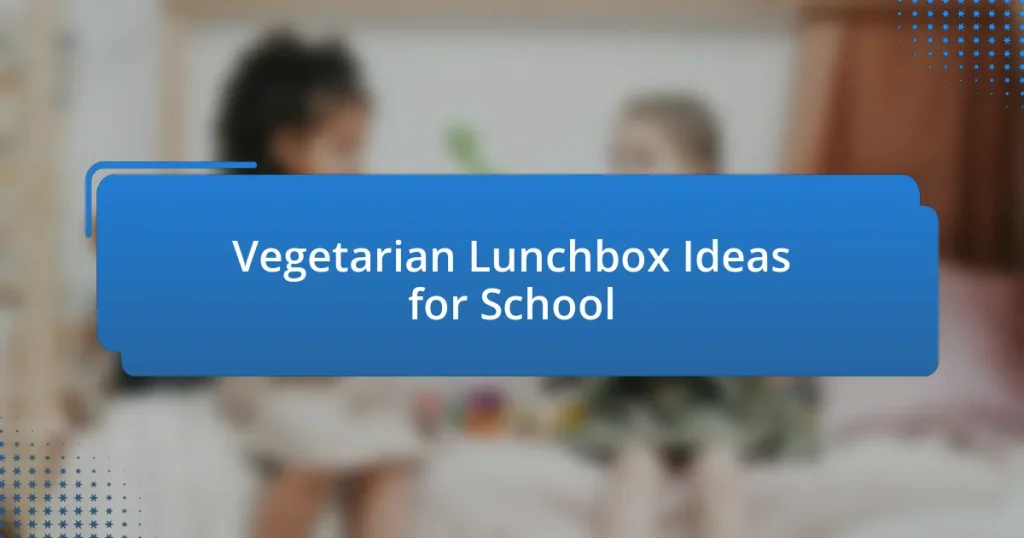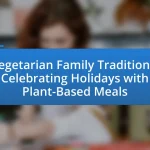Vegetarian lunchbox ideas for school encompass a range of nutritious and appealing options, including hummus and veggie wraps, quinoa salad with black beans and corn, and whole grain pasta salad. These meals are designed to provide essential nutrients such as protein, iron, calcium, and fiber while promoting health and environmental sustainability. The article discusses how to create visually appealing lunchboxes, the importance of key nutrients, and practical tips for meal preparation and packing. Additionally, it highlights the benefits of involving children in the lunch preparation process and offers creative recipes and ingredient suggestions to ensure variety and enjoyment in vegetarian school lunches.
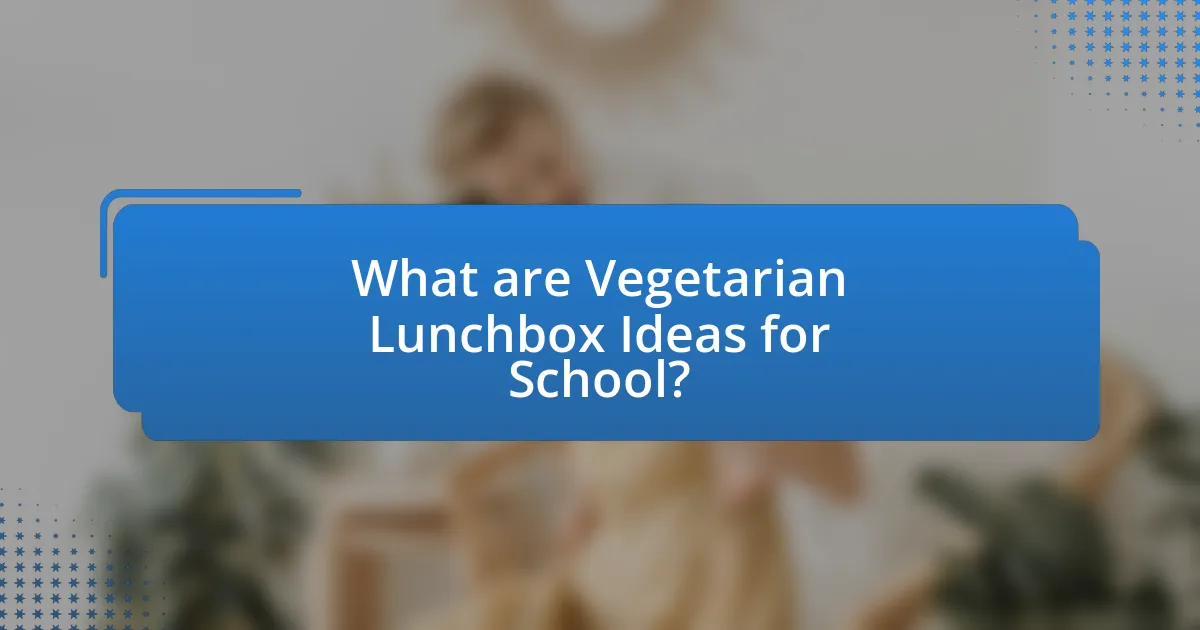
What are Vegetarian Lunchbox Ideas for School?
Vegetarian lunchbox ideas for school include a variety of nutritious and appealing options such as hummus and veggie wraps, quinoa salad with black beans and corn, and whole grain pasta salad with cherry tomatoes and spinach. These meals provide essential nutrients and are easy to prepare. For instance, hummus is rich in protein and fiber, while quinoa is a complete protein source, making these choices both healthy and satisfying for students.
How can vegetarian lunchboxes be nutritious and appealing?
Vegetarian lunchboxes can be nutritious and appealing by incorporating a variety of colorful fruits, vegetables, whole grains, and protein sources. Including items such as quinoa, chickpeas, and a mix of raw or roasted vegetables ensures a balanced intake of essential nutrients. For example, a lunchbox containing hummus, carrot sticks, cherry tomatoes, and whole grain pita provides fiber, vitamins, and healthy fats, making it both satisfying and visually attractive. Research indicates that meals rich in diverse plant-based foods can improve overall health and well-being, supporting the idea that a well-planned vegetarian lunchbox can meet nutritional needs while being enjoyable to eat.
What key nutrients should be included in a vegetarian lunchbox?
A vegetarian lunchbox should include key nutrients such as protein, iron, calcium, fiber, and vitamins B12 and D. Protein can be sourced from legumes, tofu, and dairy products, which are essential for muscle repair and growth. Iron, important for oxygen transport in the blood, can be obtained from leafy greens, lentils, and fortified cereals. Calcium is crucial for bone health and can be found in dairy products, fortified plant milks, and leafy greens. Fiber, which aids digestion, is abundant in whole grains, fruits, and vegetables. Vitamins B12 and D are vital for energy metabolism and bone health, respectively; B12 is primarily found in dairy and fortified foods, while vitamin D can be sourced from fortified foods and sunlight exposure.
How can presentation enhance the appeal of vegetarian lunchboxes?
Presentation can significantly enhance the appeal of vegetarian lunchboxes by making them visually attractive and inviting. A well-arranged lunchbox with colorful vegetables, neatly cut fruits, and appealing shapes can stimulate appetite and interest, especially among children. Research indicates that visual appeal plays a crucial role in food acceptance; for instance, a study published in the journal “Appetite” found that children are more likely to eat fruits and vegetables when they are presented in an aesthetically pleasing manner. This suggests that thoughtful presentation not only enhances the visual aspect but also encourages healthier eating habits among students.
Why choose vegetarian options for school lunches?
Choosing vegetarian options for school lunches promotes better health and environmental sustainability. Research indicates that vegetarian diets can lower the risk of chronic diseases such as obesity, heart disease, and diabetes, as they are typically lower in saturated fats and higher in essential nutrients. Additionally, adopting vegetarian meals reduces the carbon footprint associated with meat production; for instance, the Food and Agriculture Organization states that livestock accounts for 14.5% of global greenhouse gas emissions. Therefore, incorporating vegetarian options in school lunches supports both student health and environmental responsibility.
What are the environmental benefits of vegetarian lunches?
Vegetarian lunches significantly reduce environmental impact by lowering greenhouse gas emissions, conserving water, and minimizing land use. Research indicates that plant-based diets can reduce carbon footprints by up to 50% compared to meat-based diets, as livestock farming is a major contributor to methane emissions. Additionally, producing plant-based foods generally requires less water; for instance, it takes approximately 1,800 gallons of water to produce one pound of beef, while only 200 gallons are needed for a pound of vegetables. Furthermore, vegetarian diets require less agricultural land, with studies showing that shifting to plant-based eating could free up to 75% of current farmland.
How do vegetarian lunches support health and wellness?
Vegetarian lunches support health and wellness by providing essential nutrients while reducing the risk of chronic diseases. These meals are typically rich in fruits, vegetables, whole grains, and legumes, which are high in fiber, vitamins, and minerals. Research indicates that diets high in plant-based foods can lower the risk of heart disease, obesity, and type 2 diabetes. For instance, a study published in the Journal of the American Heart Association found that individuals who consume more plant-based foods have a significantly lower risk of cardiovascular disease. Additionally, vegetarian lunches can enhance mental well-being, as a diet rich in nutrients supports cognitive function and mood stability.
What are some popular vegetarian lunchbox ingredients?
Popular vegetarian lunchbox ingredients include hummus, whole grain wraps, fresh fruits, vegetables, cheese, and nuts. Hummus serves as a nutritious dip for vegetables or spreads for wraps, while whole grain wraps provide a versatile base for various fillings. Fresh fruits like apples, bananas, and berries offer natural sweetness and essential vitamins. Vegetables such as carrots, cucumbers, and bell peppers add crunch and fiber. Cheese provides protein and calcium, and nuts contribute healthy fats and additional protein. These ingredients are commonly chosen for their nutritional value and ease of preparation, making them ideal for school lunches.
Which fruits and vegetables are best for lunchboxes?
Carrot sticks, cucumber slices, apple wedges, and grapes are among the best fruits and vegetables for lunchboxes. These options are not only easy to pack but also provide essential nutrients. Carrots are high in beta-carotene, which supports eye health, while cucumbers are hydrating and low in calories. Apples offer fiber and vitamin C, and grapes are rich in antioxidants. These fruits and vegetables are also appealing to children, making them more likely to be consumed during lunch.
What grains and proteins can be included in vegetarian lunches?
Vegetarian lunches can include grains such as quinoa, brown rice, and whole wheat pasta, along with proteins like lentils, chickpeas, and tofu. Quinoa is a complete protein, providing all nine essential amino acids, while lentils and chickpeas are rich in protein and fiber, making them excellent choices for a balanced meal. Brown rice and whole wheat pasta offer complex carbohydrates that provide sustained energy, essential for school activities. These grains and proteins not only contribute to nutritional needs but also support a varied and satisfying vegetarian diet.
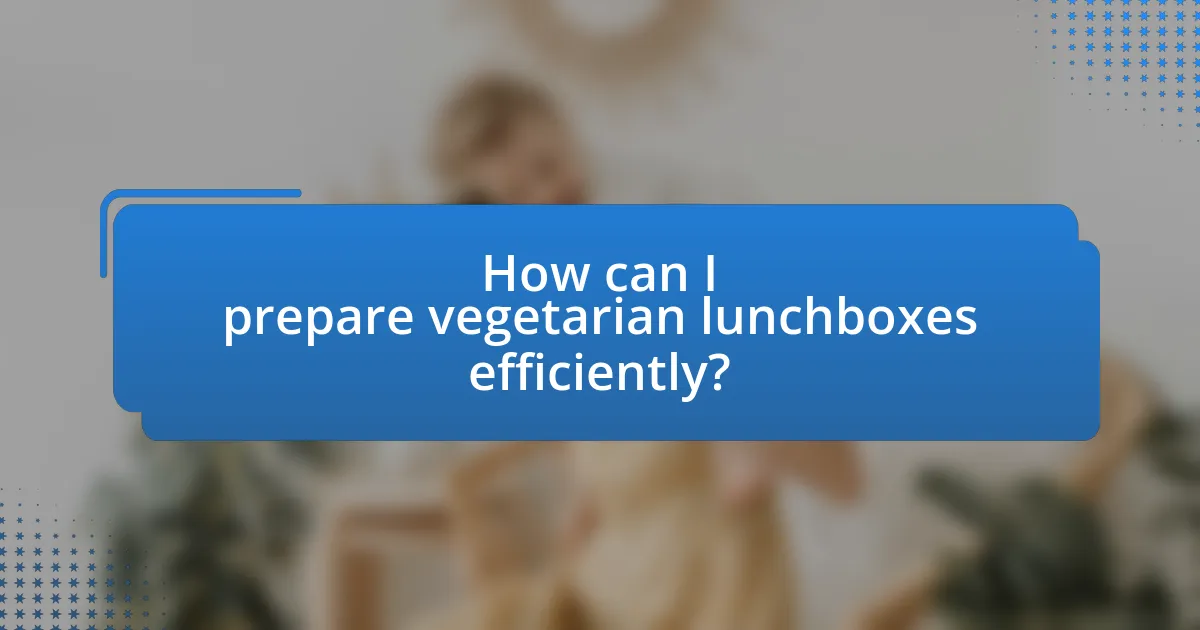
How can I prepare vegetarian lunchboxes efficiently?
To prepare vegetarian lunchboxes efficiently, plan meals in advance and batch-cook ingredients. This approach allows for quick assembly of lunchboxes by having pre-prepared items like grains, roasted vegetables, and proteins such as beans or tofu ready to use. Research indicates that meal prepping can save time and reduce food waste, as it encourages the use of ingredients before they spoil. By organizing ingredients into containers, you can streamline the packing process, ensuring a variety of nutritious options are available for each lunchbox.
What are some meal prep tips for vegetarian lunchboxes?
Meal prep tips for vegetarian lunchboxes include planning balanced meals, using seasonal vegetables, and incorporating protein sources like beans or tofu. Planning meals in advance ensures a variety of nutrients and flavors, while seasonal vegetables enhance freshness and taste. Incorporating protein sources, such as chickpeas or lentils, provides essential amino acids, making the meal more satisfying. Additionally, using airtight containers helps maintain freshness and prevents spills, ensuring that the lunchbox remains appealing and nutritious.
How can batch cooking simplify lunch preparation?
Batch cooking simplifies lunch preparation by allowing individuals to prepare multiple meals at once, reducing daily cooking time. This method enables the creation of a variety of vegetarian dishes that can be stored and easily assembled for school lunches. For instance, preparing large quantities of grains, legumes, and vegetables in advance means that parents can quickly combine these components into nutritious lunchboxes without the need for extensive daily cooking. Studies show that meal prepping can save up to 2 hours per week in meal preparation time, making it an efficient strategy for busy families.
What storage solutions work best for lunchbox ingredients?
The best storage solutions for lunchbox ingredients include airtight containers, insulated lunch bags, and reusable silicone bags. Airtight containers prevent moisture and air exposure, keeping ingredients fresh and preventing spoilage. Insulated lunch bags maintain temperature, ensuring that perishable items like fruits and dairy remain safe to consume. Reusable silicone bags are versatile, allowing for easy storage of various ingredients while being eco-friendly. These solutions effectively preserve the quality of vegetarian lunchbox ingredients, making them ideal for school lunches.
How can I involve kids in the lunchbox preparation process?
Involving kids in the lunchbox preparation process can be achieved by assigning them specific tasks such as selecting fruits and vegetables, assembling sandwiches, or packing snacks. Research indicates that children who participate in meal preparation are more likely to try new foods and develop healthier eating habits. For example, a study published in the Journal of Nutrition Education and Behavior found that children who helped prepare meals were more inclined to consume fruits and vegetables. By engaging kids in these activities, parents can foster a sense of ownership and excitement about their meals, making lunchtime more enjoyable.
What are fun ways to let kids choose their lunch ingredients?
One fun way to let kids choose their lunch ingredients is to create a “build-your-own” lunch station, where children can select from a variety of vegetarian options such as different types of bread, spreads, vegetables, and proteins. This interactive approach encourages kids to engage with their food and make choices that reflect their preferences. Research shows that children are more likely to eat healthy foods when they have a hand in selecting them, as it fosters a sense of ownership and excitement about their meals.
How can kids help in the preparation of their vegetarian lunches?
Kids can help in the preparation of their vegetarian lunches by participating in tasks such as washing vegetables, assembling sandwiches, and packing their lunchboxes. Engaging in these activities not only teaches them essential cooking skills but also encourages them to take ownership of their meals. Research indicates that children who are involved in meal preparation are more likely to try new foods and develop healthier eating habits. For example, a study published in the Journal of Nutrition Education and Behavior found that children who helped prepare meals were more inclined to consume fruits and vegetables.
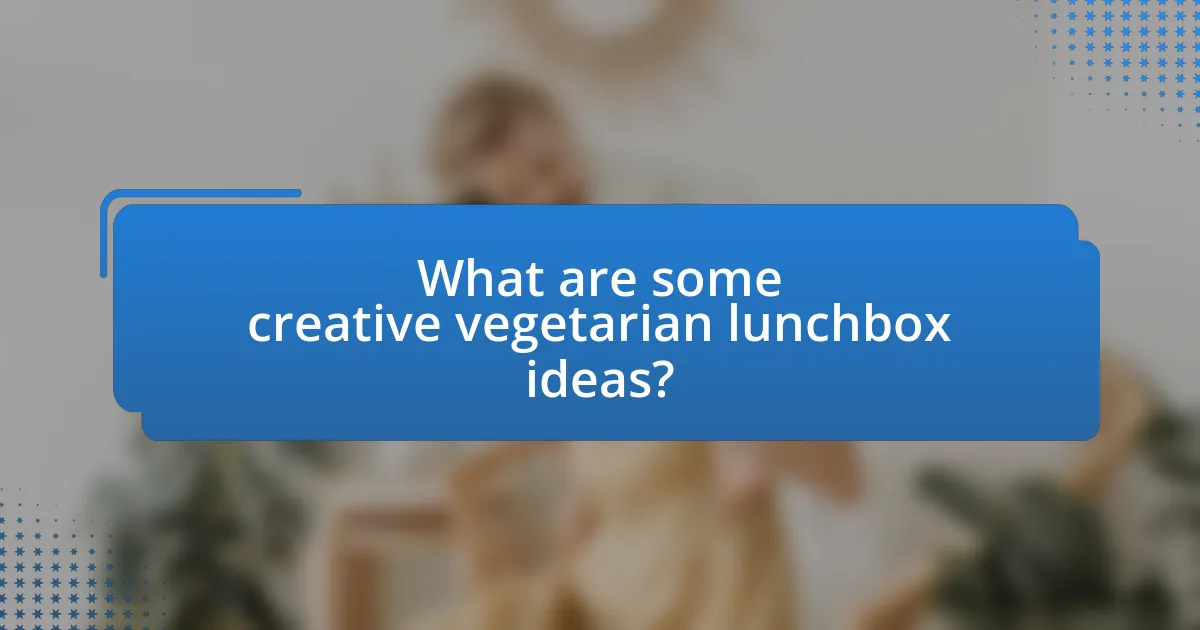
What are some creative vegetarian lunchbox ideas?
Creative vegetarian lunchbox ideas include quinoa salad with black beans and corn, hummus with carrot and cucumber sticks, and a wrap filled with spinach, feta, and roasted red peppers. These options are nutritious and appealing, making them suitable for school lunches. Quinoa salad provides protein and fiber, while hummus offers healthy fats and vitamins. Wraps are versatile and can be customized with various vegetables and spreads, ensuring a balanced meal that kids will enjoy.
What are some easy vegetarian lunchbox recipes?
Some easy vegetarian lunchbox recipes include quinoa salad, hummus and veggie wraps, and caprese skewers. Quinoa salad combines cooked quinoa with diced vegetables, such as cucumbers and bell peppers, and is often dressed with olive oil and lemon juice, providing a nutritious and filling option. Hummus and veggie wraps consist of whole grain tortillas spread with hummus and filled with assorted fresh vegetables like spinach, carrots, and bell peppers, making them both tasty and easy to prepare. Caprese skewers feature cherry tomatoes, mozzarella balls, and fresh basil drizzled with balsamic glaze, offering a refreshing and visually appealing choice. These recipes are not only simple to make but also ensure a balanced meal for school lunches.
How can wraps and sandwiches be made vegetarian-friendly?
Wraps and sandwiches can be made vegetarian-friendly by incorporating a variety of plant-based ingredients such as vegetables, legumes, and dairy alternatives. For instance, using hummus or avocado as spreads adds creaminess while providing healthy fats. Additionally, filling wraps and sandwiches with ingredients like roasted vegetables, spinach, cucumbers, bell peppers, and sprouts enhances flavor and nutrition. Legumes such as chickpeas or black beans can serve as protein sources, while cheese or plant-based cheese alternatives can add richness. This approach not only caters to vegetarian diets but also ensures a balanced meal rich in vitamins and minerals.
What are some creative salads that can be packed for lunch?
Creative salads that can be packed for lunch include quinoa salad with black beans, corn, and avocado; Mediterranean chickpea salad with cucumbers, tomatoes, and feta cheese; and a pasta salad with cherry tomatoes, spinach, and pesto. These salads are nutritious, easy to prepare, and maintain their freshness when packed. For instance, quinoa is a complete protein, making it an excellent choice for a filling meal, while chickpeas provide fiber and essential nutrients. Additionally, pasta salads can be made in advance and stored, making them convenient for busy school days.
How can I ensure variety in vegetarian lunchboxes?
To ensure variety in vegetarian lunchboxes, incorporate a diverse range of ingredients and meal types. This can be achieved by rotating between different grains, legumes, vegetables, and proteins each week, such as quinoa, chickpeas, spinach, and tofu. Additionally, including various preparation methods—like roasting, steaming, or raw—can enhance texture and flavor. Research indicates that a varied diet not only improves nutrient intake but also keeps meals interesting, which is crucial for maintaining enthusiasm for healthy eating among children.
What themes can be used to create diverse lunchbox options?
Themes that can be used to create diverse lunchbox options include Mediterranean, Asian, Mexican, and seasonal themes. The Mediterranean theme can feature items like hummus, pita, olives, and tabbouleh, which are rich in flavors and nutrients. The Asian theme can incorporate sushi rolls, edamame, and rice paper wraps, providing a variety of textures and tastes. The Mexican theme can include quesadillas, black beans, and corn salad, offering a vibrant and hearty selection. Seasonal themes can utilize fresh produce available during specific times of the year, such as pumpkin in the fall or berries in the summer, ensuring that lunchboxes are not only diverse but also aligned with seasonal availability. These themes promote variety and encourage children to explore different cuisines while maintaining a vegetarian focus.
How can leftovers be creatively reused in lunchboxes?
Leftovers can be creatively reused in lunchboxes by transforming them into new dishes, such as using roasted vegetables in wraps or salads. For example, leftover roasted sweet potatoes can be added to a quinoa salad, enhancing both flavor and nutrition. Additionally, leftover grains like rice or couscous can serve as a base for grain bowls, topped with fresh vegetables and a protein source like chickpeas. This approach not only minimizes food waste but also provides variety in meals, making them more appealing to students. Studies show that incorporating diverse ingredients can increase the likelihood of children consuming their lunches, thus promoting healthier eating habits.
What are some tips for packing vegetarian lunchboxes?
To pack vegetarian lunchboxes effectively, include a variety of colorful fruits and vegetables, whole grains, and protein sources. This ensures balanced nutrition and keeps meals interesting. For instance, using whole grain wraps filled with hummus and assorted veggies provides fiber and protein, while adding fruits like apple slices or berries offers natural sweetness and vitamins. Incorporating nuts or seeds can enhance protein content and add crunch. Additionally, using compartmentalized containers helps keep different food items fresh and visually appealing, encouraging children to eat a diverse range of foods.
How can I keep food fresh and safe until lunchtime?
To keep food fresh and safe until lunchtime, store it in an insulated lunch bag with ice packs. Insulated bags maintain a stable temperature, while ice packs help keep perishable items below 40°F, which is crucial for preventing bacterial growth. According to the USDA, food should not be left in the temperature danger zone (40°F to 140°F) for more than two hours to ensure safety. Additionally, using airtight containers can further protect food from spoilage and contamination.
What are the best containers for packing vegetarian lunches?
The best containers for packing vegetarian lunches are bento boxes, glass containers, and stainless steel lunchboxes. Bento boxes are ideal for portion control and variety, allowing for separate compartments for different food items, which is beneficial for maintaining the freshness and integrity of vegetarian ingredients. Glass containers are durable, microwave-safe, and do not retain odors, making them suitable for reheating meals. Stainless steel lunchboxes are lightweight, eco-friendly, and resistant to rust, providing a long-lasting option for transporting vegetarian meals. These containers effectively preserve the quality of vegetarian foods, ensuring they remain fresh and appetizing until lunchtime.
